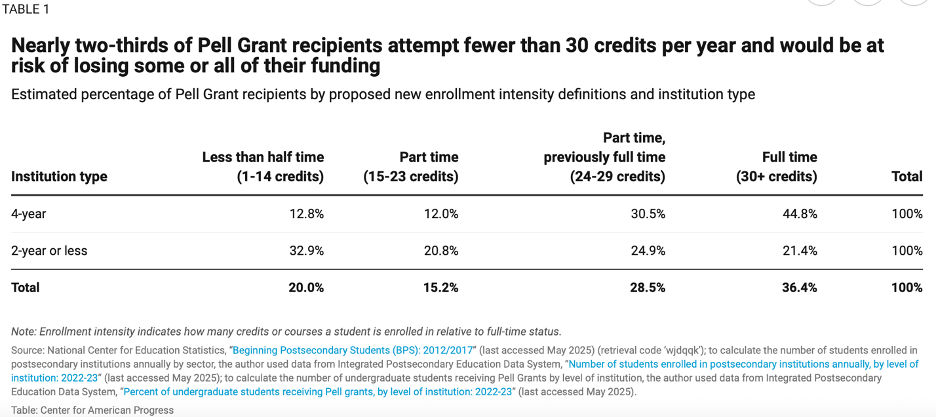Several proposed changes to Pell Grant eligibility were included in the House of Representatives Budget Bill, passed in May. Most of the higher education community is critiquing these changes. Pell Grants are need-based awards, and the maximum Pell Grant award for the academic year 2024-2025 is $7,395.
The first of these changes proposes that the full-time grant will only be awarded to students who complete 30 semester hours per year (15 per term). This is an increase from 12 semester hours per term (24 per year). Students completing 30 semester hours per year should graduate from college in four years (30 credits times 4 years equals 120 semester hours).
The Congressional Budget Office (CBO) estimated that more than half of all Pell Grant recipients will be impacted negatively by this change, and only 20% will increase their courses to receive the higher award. The CBO estimates that enacting this provision would save $7.1 billion over the period of 2025-2034.
The second of these changes increases the minimum requirement for half-time benefit from 6 semester hours (half of 12 semester hours) to 7.5 semester hours, half of 15 semester hours. It also eliminates the Pell grant for any student who attends less than half-time.
Most college courses are three semester hours. The next most frequently offered courses are four-credit-hour lab courses. Completing more than six credit hours means that students will likely have to sign up and complete three three-credit-hour courses. This will be a tough standard to meet.
The CBO estimated that approximately 10 percent of existing Pell Grant recipients are enrolled in fewer than six semester hours per term. The change that everyone is complaining about only began in the 2024-2025 academic year. The CBO estimates that approximately one-third of these recipients would increase their enrollments to meet the new minimum standard. The CBO estimates $687 million in savings over the 2025-2034 period.
Lastly, the bill authorizes additional funding of $10.5 billion from 2025 to 2034 to offset the projected deficit in Pell funding.
Community Colleges Will Be Impacted Most
Sara Weissman wrote an article for Inside Higher Ed indicating that the biggest impact of these changes will occur at U.S. community colleges. She cites the specific impact on part-time students, who comprise more than two-thirds of community college students nationwide.
Ms. Weissman writes that students who attend less than half-time will have the biggest impact. Oddly enough, that claim does not match the CBO’s projected savings. She also does not mention that the grant has only recently been expanded to students who attend less than half-time. According to the CBO, the percentage of students who receive a Pell grant and who attend less than half-time is 10%.
For the 2023-2024 academic year, approximately 6.4 million students received Pell grants. The number of students receiving Pell grants for the 2024-2025 academic year is 6.9 million. Assuming the CBO’s estimate of 10% is accurate, that implies 690,000 students will be impacted. The estimated savings are $687 million or approximately $1,000 per student, because students attending less than full-time are prorated a percentage of a full grant.
Citing a report from the Center for American Progress (CAP), Ms. Weissman writes that these changes could impact three million students (changing the definition of full-time from 24 semester hours to 30 semester hours) and 1.2 million students (eliminating benefit for less than half-time). While the first number appears to be in line with the CBO projections, the second number is almost double.
The CAP provides a table that estimates the numbers of students impacted by these changes. It is appended below.

As you might expect, Pell recipients at four-year colleges have different attendance patterns than at two-year colleges. Only 12.8% of four-year students receiving Pell are less than half-time, while approximately 33% of two-year students are less than half-time.
Ms. Weissman quoted David Baime, the SVP of government relations for the American Association of Community Colleges, as stating that a conservative estimate is that 20% of community college students will lose Pell altogether. I assume they estimated that 12.9% would move from less than half-time to half-time or greater.
Many community colleges have low or no tuition programs for residents. Some no-tuition plans are a last-dollar option, meaning the program pays for tuition after applying any financial aid. If students are using Pell grants to pay for tuition, that impacts the community colleges as well as the students.
At the same time, the less-than-half-time benefit is new to the 2024-2025 academic year. For decades, students attending college less than half-time were not eligible for financial aid, including Pell grants.
Ms. Weissman writes that the impact is as big for the community colleges as it is for their students. I can understand how the shift from the full-time definition of 24 credit hours to 30 hours would be impactful. According to the CAP table above, that accounts for 24.9% of community college students. Not only is it 24.9% of students, but all of them take at least 24 credit hours each year.
It’s difficult to parse the financial impact without a more detailed breakout of the less-than-half-time category. The AACC estimates that 20% of students will lose Pell altogether. At the same time, the dollar amount of the Pell grant varies based on the number of credits earned. If most students take one course each year, the number is small.
The Language of the Bill is Unclear
Ms. Weissman writes that the bill was unclear as to whether half-time would be defined as 7.5 credits per term (half of 15 credits times 2 terms equals 30 credits—the new full-time standard) or remain at 6 credits. She quotes a consultant who contacted staffers who drafted the bill to confirm that the new definition of half-time is 7.5 credits.
Because the new bill defines full-time as 30 credits over a year and not as 15 per term, Ms. Weissman writes that others are concerned that calculating the proper award will be impossible since students do not always take the same number of credits per term. Adding and dropping credits during a term could change the award as well.
Another issue with the bill is that the full-time student definition for loans is still 12 semester hours per term. A few of the individuals contacted by Ms. Weissman expressed concern that the Department of Education’s information technology systems would not be able to adapt to these changes. I concur with their assessment. Major changes like this are difficult to implement.
Changes I Recommend
It’s been known for years that less than half of all students graduate with a bachelor’s degree in four years. Approximately 60% take five years to graduate. The previous full-time definition was 12 credits per term, 24 credits per year. A student completing 24 credits per year will graduate in five years. I recommend going back to the full-time standard of 12 credits per term (and 24 per academic year) that represents the experiences of most students.
It’s also well known that many students attend part-time and thus take longer than five years to graduate. A student can only receive a Pell grant for 12 full-time terms (defined as the Lifetime Eligibility Used – LEU), which represents six years. The number of terms does not increase if you attend college less than full-time.
A student who completes 12 credit hours per year (the current definition of half-time) will complete college in 10 years (12 times 10 equals 120). When I was president of APUS, most of our students attended college part-time. The average number of years to graduate was 5.9, so it was close to six years.
However, most of our students transferred some credits for courses taken at previously attended institutions. The time to complete an undergraduate degree would have been longer by a year or two if you factored in the time it took to complete those additional courses at a previously attended institution.
Students who attend college part-time are generally working full-time, and some are parents. A popular explanation for why these students are unable to complete a bachelor’s degree in five years is that “life gets in the way.”
I recommend that the half-time definition continue at 6 credits per term and that no Pell grant be awarded for less than half-time students. Serious students will find a way to complete 6 credits per term. When they can’t, they’ll either stop out for a term or find a way to pay for a single course out of pocket.
I am a fan of Pell grants. It’s important to remember that they are need-based. As far back as 2009, I wrote about the fact that Pell grants have not kept up with the rising costs of attending college. I recently wrote about the potential for increased financial aid fraud from some Pell applicants. Pell grants are vital to low-income students. I was able to attend Duke University by receiving a Basic Education Opportunity Grant (predecessor to Pell grants) as part of my financial aid package. The Department of Education needs to take action to curb abuses. At the same time, making it more difficult to receive grants by increasing credit requirements is not the way to go with half-time and full-time students.
If Congress wants to create a financial aid system to encourage part-time students who are less than half-time to attend college, it should build a system from scratch, examining the reasons why students attend less than half-time and determining what financial aid assistance would make a difference for them.
Meanwhile, let’s keep the existing definitions of full-time and half-time and revert Pell grant eligibility to a minimum of half-time.











